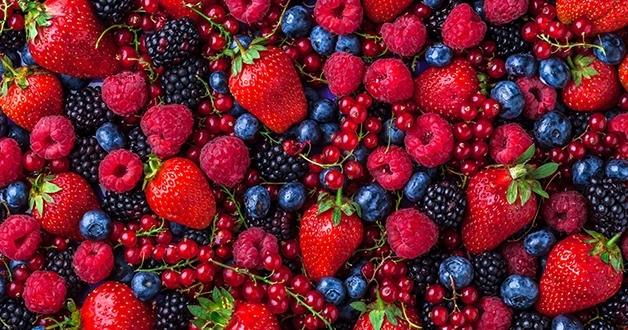
Forest fruits - few calories, lots of vitamins
0
1699
Forest fruits contain few calories but are rich in vitamins, minerals, antioxidants and fiber. Approximately 75-89% is the water content. There are also a few proteins in them and very little fat. But if you're on a diet, remember that fruity and glucose fruit contains mostly simple carbohydrates.
Why should we eat more berries?
Because they contain vital vitamins and minerals. Forest fruits are a valuable source of soluble vitamin C and folic acid.
The latter is a B group vitamin needed for healthy nerves and a cardiovascular system. Vitamin C is a powerful antioxidant that neutralizes free radicals.
There is plenty of potassium in the berries that is a good helper to prevent cardiovascular disease. Potassium is also necessary for the work of the muscles. It ensures that you will not feel tired. More potassium is contained in blackcurrant, raspberries, cherries, red and white currants, gooseberries.
Depending on the ratio of alkaline minerals - potassium and sodium, the fruits have different diuretic properties: the lower the amount of sodium and the greater the potassium, the stronger the diuretic effect.
Fruits contain magnesium, which has a beneficial effect on the cardiovascular, nervous system, muscles and bone health.
Fruit is also a source of iron. Since iron is included in organic compounds, its absorption in the intestine is aided by the vitamins and minerals contained in the fruit.
Fruits are rich in organic acids, pectin, and tanning substances.
read more
Thanks to fiber and pectin, fruits help normalize bowel emptying. But eating large amounts of fruit (when strawberries mature, some people eat up to 2 pounds a day!) Can cause discomfort in the digestive tract. The reason for this is not only the fiber, but also the fructose in it.
The more colorful, the more useful!
Nature has enriched the forest fruits with bright colors. It is not by chance that the notorious polyphenols have a blue, purple and bright yellow color. They stand out! Polyphenols are powerful antioxidants with a powerful anti-cancer effect.
The brightest - red, yellow, and orange - are the colors of alpha and beta carotenoids and antioxidant lycopene, which are considered particularly important in preventing almost all known diseases.
How many fruits do you have to eat in a day?
Nutritionists recommend that older people eat 600g of vegetables daily and 300g of fruit a day. For children aged under 3, the recommended daily amount is about 100-200 grams of fruits and vegetables, and for the over 10-year-olds - 200-250 grams.
In the season of berries is necessary and can eat a little more than them.
Who is not recommended for forest fruits?
You should consume moderate berries if you suffer from diabetes, gallbladder and bile ducts, kidney stones and allergies. In the formation of kidney stones, it is not recommended to eat red currants, gooseberries, blueberries, rhubarb.
Useful substances in percentages
100 grams of strawberries contain: 84.5% water, 0.8 grams of protein, 0.4 grams of fat, 6.3 grams of carbohydrate, 4 grams of fiber, 32 kcal.
Note: they contain 60 mg of vitamin C, 40 mg of calcium, 161 mg of potassium.
100 grams of red currant contains: 85% water, 0.6 grams of protein, 0.2 grams of fat, 7.3 grams of carbohydrate, 2.5 grams of ballast, 33.4 kcal.
Note: Vitamin C in red currant is less than in strawberries - 25 mg, but potassium is 275 mg!
100 grams of currant contains: 85% water, 1 gram of protein, 0.2 grams of fat, 7.3 grams of carbohydrates, dietary fiber - 3 grams, 35 kcal.
Note: According to vitamin C content, currants (and buckwheat) are recorders! In black currant, vitamin C is 200 mg!
100 grams of blueberries contain: 86.5% water, 1.1 grams of protein, 0.6 grams of fat.
Note: They contain a lot of vitamin A - carotene and flavonoids that improve visual function. Fruits also contain rare succinic acid.


